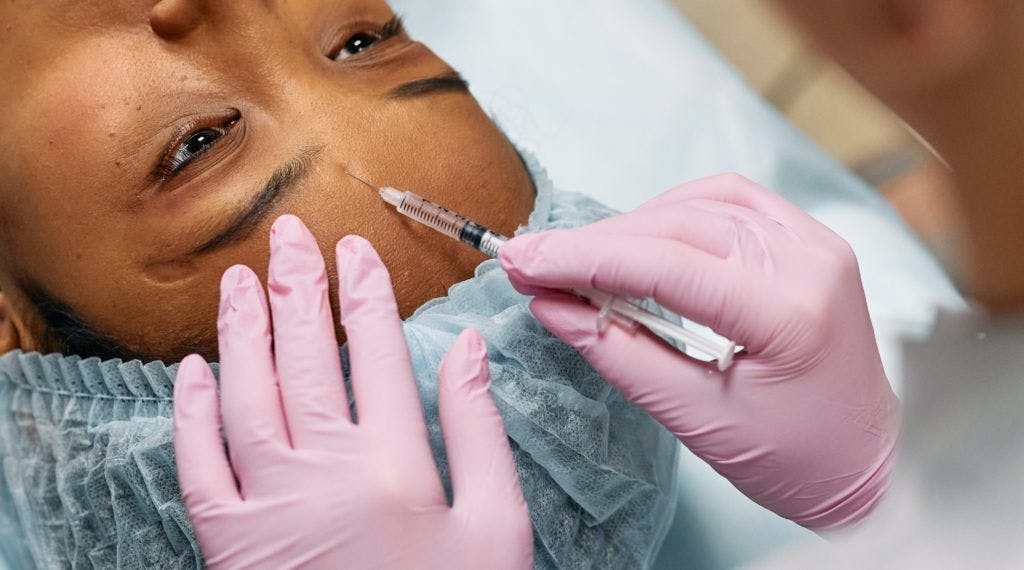Complications From Injectables And Darker Skin

Many aesthetic medicine textbooks are illustrated with images of patients with pale complexions. This has left a knowledge gap when it comes to complications from injectables and darker skin.
Here we examine key issues surrounding injectables that aesthetics practitioners should be aware of when treating patients of colour.

Considering patient suitability and timelines
Presumably, as a result of injectors and other medical aesthetics technicians being unsure of the difference when treating different skin colours, there has been an anecdotal increase in patients with darker skin seeking help for complications.
An October 2020 article, published in Volume 41 of the Dermatology Times, advised that some “adverse reactions to cosmetic procedures occur more often in patients with darker skin types. Patients should be counselled on appropriate cosmetic procedures for their skin type, according to Cheryl M. Burgess, M.D., at the Skin of Colour Update virtual meeting.”
Dr Burgess is the founder and president of the Centre for Dermatology and Dermatologic Surgery in Washington, D.C., USA.
At the Skin of Color Update virtual meeting, Dr Burgess noted she was seeing an increased number of patients of colour for correctional procedures. “With the advent of medical spas and the cross-over of various specialists into cosmetic procedures, I have seen an upsurge in the number of patients with Fitzpatrick skin types IV, V and VI who come to me because they experienced an adverse event following a treatment involving a laser or light-based device, filler or neuromodulator injection, or chemical peel,” she told those assembled.
“Careful patient selection is important for achieving the desired outcome with any cosmetic procedure, and thorough counselling should be provided at consultation on procedures that are appropriate for the individual’s skin type,” she advised.
Complications from injectables and darker skin
Bruising is the most frequently seen complication in injectables patients of all skin tones. Hyperpigmentation may also occur following soft tissue filler or botulinum toxin. This is especially true where “serial puncture” techniques are used and the injections are performed quickly.
Hyperpigmentation, hypopigmentation and scarring are more common among patients with Black skin. This can make darker skins more challenging to those who are inexperienced.
It is, therefore, crucial to:
– talk to your patient about these potential outcomes during the initial consultation
– take it slowly when injecting to minimise the likelihood of complications
– counsel the patient as to appropriate aftercare advice
– be able to spot bruising and hyperpigmentation in darker skin.
Dr Burgess advises “Filler injections in skin of colour patients are best done slowly using a linear threading technique.”
She also cautions that a “slow and steady” approach to injectables for aesthetics patients with darker skin tones is best, even if this means achieving the desired results over a number of appointments.
Improve your injecting of patients of colour

Completing aesthetic medicine training courses with a reputable educational establishment should include details on treating different skin colours. You should also aim to do your own reading around the subject, even if you have already qualified, to ensure you are up-to-date with the latest research and techniques.
Aesthetician and founder of the Black Skin Directory, Dija Ayodele told the Aesthetics journal in 2018, “I think skin of colour isn’t focussed upon enough in education. In America there are very specific textbooks on treating skin of colour but we don’t always see that here in the UK.”
Furthermore, at Harley Academy, students taking our Foundation Training in Botox & Dermal Fillers and our 1:1 Injectables Training Sessions are required to treat their own patients.
In order to get the broadest range of experience from these expertly-guided sessions, it is wise to vary the skin tones, ages and genders of your injectables patients. The more hands-on experience you can get in treating a wide variety of people and areas, the better.
This will help you develop a deep understanding of the different approaches required and the types of scenarios you may face as an injector. It will also build your confidence as you gain experience in tackling each unique case.
Reconsidering your initial approach

Remember that it is not just about the physical treatments; it is important to tailor your clinical consultation to each individual.
It can be challenging to talk about race, skin colour and ethnicity, so have your approach prepared in advance. Do not be fooled by the appearance of pale skin without exploring the individual’s background and reaction to sunlight.
Black aesthetics patients and those with darker skin tones should have the possible complications associated with their skin explained to them. They may require further information, more detailed explanations and longer treatment times. Remember to allow sufficient time for this when booking the appointment.
Should your patients have questions you are unable to answer, firstly, if you cannot find the answer for them straight away, do not treat them that day. The patient must be fully informed about their treatment before they can make the decision as to whether or not to go ahead.
Secondly, in addition to researching the answer to their question, don’t forget to ask your professional network. This could be messaging your WhatsApp group of other medical aesthetics experts or posting on Comma, the online community for medical aesthetics.
Review your marketing
Another point worth mentioning here is your marketing. This applies whether it’s your professional Instagram page, website or printed materials. What are you doing here to make Black and darker skin patients feel welcome coming to you?
The aesthetics industry has typically tended towards pale-skinned models. If you aren’t showing that you treat people with darker skin tones, there may be an unnecessary initial hurdle of ensuring these patients feel welcome and understood.
We hope these pointers on treating darker skin are helpful. If you have any questions, do let us know in the comments on our Harley Academy Instagram page.
All information correct at the time of publication. Article last fact-checked: 20 January 2023
Download our full prospectus
Browse all our injectables, dermal fillers and cosmetic dermatology courses in one document
By submitting this form, you agree to receive marketing about our products, events, promotions and exclusive content. Consent is not a condition of purchase, and no purchase is necessary. Message frequency varies. View our Privacy Policy and Terms & Conditions
Attend our FREE open evening
If you're not sure which course is right for you, let us help
Join us online or in-person at our free open evening to learn more
Our Partners













STAY INFORMED
Sign up to receive industry news, careers advice, special offers and information on Harley Academy courses and services

